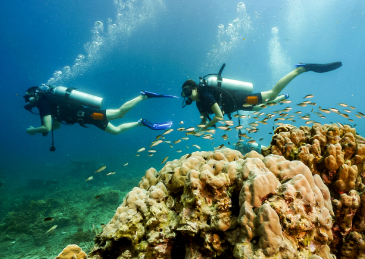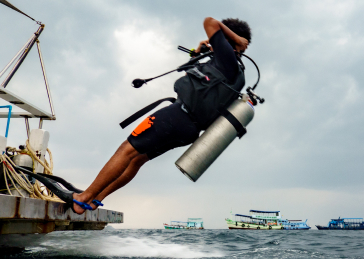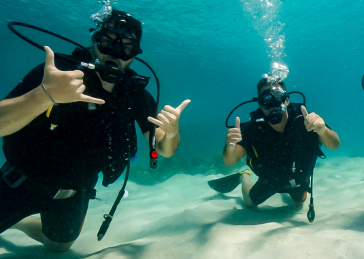15th May 2024
Koh Tao offers an exceptional try scuba diving experience for beginners in scuba diving.
Understand the basic requirements and gear needed for a successful dive.
Explore the vibrant marine life, including tropical fish and coral reefs.
Learn about the best times to dive and how to prepare mentally and physically.
Discover the importance of safety and RAID certification for diving enthusiasts.
Imagine slipping beneath the waves into a world where vibrant corals, playful fish, and the gentle sway of the ocean welcome you to an aquatic wonderland. That’s Koh Tao, a diving sanctuary that beckons beginners and seasoned divers alike for underwater exploration. Here, the ocean is your playground, and every dive is a story waiting to unfold.
Welcome to Koh Tao: A Scuba Diving Sanctuary
Diving into Koh Tao’s waters is like opening a door to another world. The island, nestled in the Gulf of Thailand, is renowned for its clear waters, abundant marine life, and friendly diving community. A try dive here offers a unique opportunity to get your fins wet and experience the thrill of scuba diving in a safe and controlled environment. Whether it’s the pull of adventure or the lure of the unknown that brings you here, Koh Tao promises an experience that will ignite a lifelong passion for the underwater world.
RAID Certification: Your Gateway to the Underwater World
Before you go on your dives, it’s essential to understand the significance of RAID certification. RAID, which stands for Rebreather Association of International Divers, is one of the most respected organizations in the dive industry, known for its commitment to safety, quality, and environmental sustainability. As a beginner, obtaining a RAID Try Dive certification is your first step towards becoming a confident and responsible diver. It’s a recognition that you’ve learned the basics under the guidance of a certified professional and are ready try diving in the shallow reefs and sandy bottoms of Koh Tao.
What to Expect on Your First Try Dive in Koh Tao
An introduction to basic scuba equipment and how to use it.
A briefing on safety procedures and underwater communication.
Guided dives in shallow waters where you’ll learn to breathe and move underwater.
An encounter with Koh Tao’s diverse marine species even on your first dive.
A taste of the freedom and tranquility that comes with floating weightlessly in the sea.
Your first try dive will be nothing short of magical. Under the supervision of your RAID-certified instructor, you’ll learn to trust your gear and your newfound skills as you descend into the calm, blue waters. You’ll practice breathing through your regulator, clearing your mask, and achieving neutral buoyancy—a sensation akin to flying. And as you become comfortable, you’ll be rewarded with sights that few get to witness: the dance of light on the ocean floor, the curious gaze of a passing fish, and the harmonious life of the reef.
The Best Season to Dive and Witness Koh Tao’s Marine Splendor
The best time to visit Koh Tao for diving is from March to September when the waters are calmest, and visibility is at its peak. During this period, the sea teems with life, and the weather is conducive to long, leisurely dives. That said, Koh Tao’s tropical climate allows for year-round diving, so don’t hesitate to plan your trip when it suits you best. The island’s dive sites are always buzzing with activity, and the water temperature remains a comfortable 28-30°C (82-86°F), making any time a good time for a try dive.
Preparing for Your Try Dive
Before you venture beneath the waves, there’s some groundwork to lay. Start with a good night’s sleep and a light meal; you’ll want to be well-rested and comfortable. Next, ensure you’re well hydrated but avoid alcohol. You’re about to engage in an activity that’s as much about mental preparation as it is about physical readiness. Scuba divers should aim to be in peak condition before any scuba dive.
Essential Gear for Your Underwater Adventure
Your gear is your lifeline underwater, so it’s crucial to familiarize yourself with it. You’ll be equipped with:
A mask that fits snugly, allowing clear vision and no leaks.
A snorkel for breathing at the surface.
Fins for efficient movement through the water.
A buoyancy control device (BCD) to help you float, hover, or sink.
A regulator to breathe from your tank.
A weight system to help you descend.
Each piece of equipment plays a vital role in your dive, and your instructor will ensure you know how to use them properly. It’s not just about comfort; it’s about building confidence in your abilities and your gear.
Understanding Dive Basics with RAID
RAID emphasizes the importance of understanding the basic principles of scuba diving. You’ll learn about pressure and how it affects your body, the importance of equalizing your ears to prevent discomfort, and the concept of no-decompression limits. These are not just rules but tools that empower you to dive safely and enjoyably.
Mental and Physical Readiness: Tips for Smooth Dives
Being mentally and physically prepared is essential. Stay calm, breathe slowly, and always listen to your instructor. Remember, diving is supposed to be fun. If you feel anxious, take a moment to relax and refocus. Physically, you don’t need to be an athlete, but basic swimming skills and comfort in the water are necessary.
Explore the Ocean and the Aquatic Wildlife of Koh Tao
Now, let’s talk about the main event—the marine life of Koh Tao. Here’s what you can expect to see:
Encounters with Colorful Coral Reefs
Koh Tao’s reefs are bustling cities of marine life. You’ll see hard corals like the brain and staghorn varieties, as well as soft corals swaying in the current. Keep an eye out for the Christmas tree worms that pop out of corals like tiny, colorful fireworks.
The Array of Tropical Fish and How to Spot Them
The fish you’ll encounter are as varied as they are vibrant. Watch for the butterflyfish with their intricate patterns, the parrotfish munching on coral, and the occasional moray eel peeking out from its hideaway. You might even be lucky enough to spot a turtle gliding by.
Remember, while it’s tempting to touch, always keep a safe distance from marine life. Your presence is an observer, not a disruptor.
It’s a privilege to witness the underwater ballet of life, and as a scuba diver, one must respect his oceanic hosts by minimizing our impact on their environment.
Navigating Your First Scuba Diving Journey
As you begin your dive, focus on following your instructor and staying close to your buddy. The underwater world can be disorienting, so trust in their guidance.
Mastery of Buoyancy: The Key to Effortless Diving
One of the first skills you’ll practice is buoyancy control. This is what allows divers to hover weightlessly, ascend, or descend with ease. It’s a skill that takes time to master, but with each breath and each adjustment on your BCD, you’ll find the sweet spot that lets you float like an astronaut in space.
Communication Underwater: Hand Signals and Safety
Underwater, your voice won’t carry, so you’ll communicate with hand signals. A thumbs-up doesn’t mean “all good” down here—it means “I need to ascend.” Learn the basic signals for “OK,” “problem,” and “low on air.” These are your lifelines to safe diving.
Always keep an eye on your instructor and buddy. Good communication is the cornerstone of a safe and enjoyable dive.
Finding Your Way: Underwater Navigation for Beginners
Navigation underwater is a thrilling challenge. You’ll start by learning to orient yourself with natural landmarks—the shape of the reef, the direction of the current—and perhaps even using a compass. It’s a bit like being a treasure hunter, where the treasure is the journey itself.
Safety First: Diving Without Compromising Well-being
Safety is paramount in diving. That’s why every precaution is taken to ensure your try dive is as safe as it is exhilarating.
RAID Safety Protocols: Ensuring a Secure Dive
RAID’s safety protocols are thorough and designed to protect you. You’ll learn about the buddy system, pre-dive safety checks, and what to do in the unlikely event of an emergency. This knowledge isn’t just for your first dive—it’s the foundation of every dive to come.
Dealing with Common Underwater Challenges
Challenges underwater are part of the adventure. You might experience foggy masks, fluctuating buoyancy, or curious sea creatures. With training and calm responses, these moments become opportunities to grow as a diver.
Post-Dive Procedures to Maintain Health and Safety
After your dive, it’s essential to debrief with your instructor, hydrate, and rest. Diving is an exertion, and your body needs time to readjust to the surface world. Share your experiences with your fellow divers—these stories are the seeds of your diving future.
Review your dive and discuss any questions with your instructor.
Stay hydrated and avoid flying or ascending to high altitudes for at least 18 hours after diving.
Log your dive, noting what you saw and how you felt. This log will be a precious record of your diving journey.
Continuing Your Diving Journey After Koh Tao
Once you’ve had a taste of the underwater realm in Koh Tao, the urge to dive deeper and explore further might just become irresistible. Continuing your diving education is the next natural step. Consider enrolling in a RAID Open Water Diver course, where you’ll expand your skills, increase your dive limits, and gain the confidence to dive in different environments. Diving is a lifelong journey, and each dive is a step towards greater adventures.
Advancing from Try Dive to RAID Open Water Diver
The RAID Open Water Diver certification is your passport to the underwater world. It’s an internationally recognized qualification that teaches you more advanced diving techniques, dive theory, and safety practices. This course typically includes a combination of classroom sessions, confined water dives to practice skills, and open water dives to experience different dive sites. With this certification, you can dive up to 18 meters (60 feet) and rent dive equipment worldwide.
Exploring Further: Next Steps in Building Your Diving Skills
After earning your Open Water Diver certification, the possibilities are endless. You can specialize in different types of diving, such as night diving, wreck diving, or underwater photography. Each specialty course hones specific skills and knowledge, allowing you to tailor your diving experiences to your interests. As you continue to dive and gain experience, you might even consider becoming a RAID Advanced Open Water Diver or pursuing professional-level courses.
Joining the Diving Community: How to Stay Involved
Becoming a diver is about more than just exploring the seas; it’s about joining a community. Connect with other divers through local dive clubs, online forums, and social media groups. Participate in dive trips and conservation projects. The diving community is welcoming and always eager to share knowledge and stories. It’s a community that not only dives together but also works to protect the oceans and marine life for future generations.
FAQ
What is a Try Dive and How Does it Differ from a Certified Dive?
A try dive is an introductory dive intended for beginners to experience scuba diving under the direct supervision of a certified instructor. It typically takes place in shallow, controlled environments and doesn’t require previous diving experience. In contrast, a certified dive is one that you can do independently after completing a certification course like the RAID Open Water Diver, which teaches you the necessary skills and knowledge for safe diving practices.
Do I Need to Know How to Swim for a Try Dive?
While you don’t need to be an Olympic swimmer, basic swimming skills and comfort in the water are essential for a try dive. You should be able to maintain yourself in the water and have a level of comfort that allows you to focus on learning the diving skills without stress.
Can I Dive with Marine Life on My First Try Dive?
Yes, even on your first try dive in Koh Tao, you’ll have the opportunity to encounter marine life. The shallow waters where try dives are conducted are teeming with aquatic creatures, and your instructor will guide you to areas where you can safely observe them.
What are RAID’s Unique Approaches to Diving?
RAID is known for its focus on safety, conservation, and the use of modern digital learning tools. It emphasizes a more ecological approach to diving, promoting the protection of underwater environments and responsible diving practices.
RAID’s training programs are designed to be thorough and up-to-date with the latest diving standards.
They provide divers with a strong foundation in dive theory and practical skills.
RAID certifications are recognized globally, allowing divers to explore the world’s oceans with confidence.
How Can I Continue To Scuba Dive After My Try Dive Experience?
To continue diving after your try dive, consider enrolling in a certification course like the RAID Open Water Diver. This will equip you with the skills and knowledge needed to dive independently. Stay involved with the diving community, continue learning, and explore different diving specialties to enhance your experiences underwater.
Diving in Koh Tao is more than just an activity; it’s an immersive experience that can transform your perspective on the world. The island’s warm waters, rich marine biodiversity, and welcoming dive community make it an ideal place for beginners to start their diving journey. With every breath you take underwater, you’ll find yourself becoming more connected to the ocean and its inhabitants. So, take the plunge, respect the marine life, and become a part of the global effort to preserve our underwater world for generations to come. The adventure of a lifetime awaits beneath the surface, and it all starts with a try dive in Koh Tao.
Dive with LBD: Your Gateway to Underwater Exploration
Whether you’re a curious beginner or a seasoned pro, our school is your portal to the wonders of scuba diving. Join us into the world beneath the waves.
¿LISTO PARA EMPEZAR?
Consulta nuestros cursos de buceo en Koh Tao





